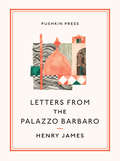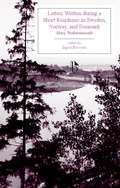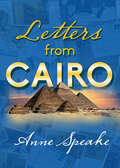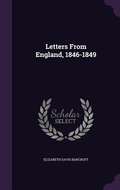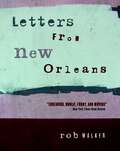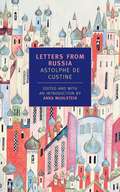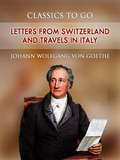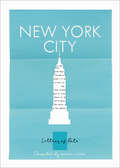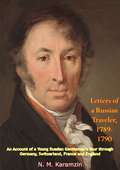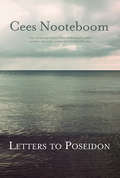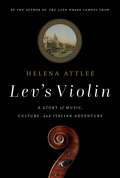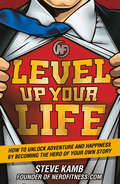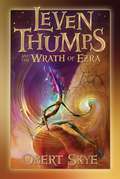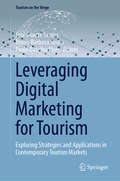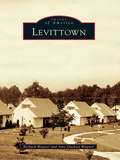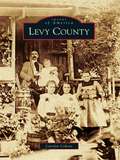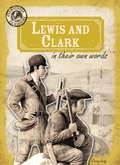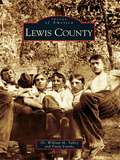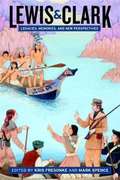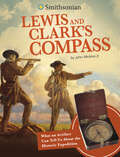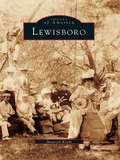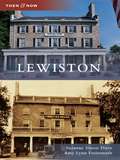- Table View
- List View
Letters From the Palazzo Barbaro
by Henry JamesThe novelist Henry James arrived in Venice as a tourist, and instantly fell in love with the city - particularly with the splendid Palazzo Barbaro, home of the expatriate American Curtis family. This selection of letters covers the period 1869-1907 and provides a unique record of the life and work of this great writer.Includes historical photographs and a foreword by Leon Edel, Henry James's biographer.
Letters Written During a Short Residence in Sweden, Norway, and Denmark
by Mary Wollstonecraft"The art of travelling is only a branch of the art of thinking," Mary Wollstonecraft wrote in one of her many reviews of works of travel writing. A Short Residenceis her own travel memoir. In a series of letters addressed to an unnamed lover, the work narrates Wollstonecraft's journey through Scandinavia in 1795, on much of which she was accompanied by her infant daughter. Passionate and personal, A Short Residenceis at once a moving epistolary travel narrative, a politically-motivated ethnographic tract, a work of scenic tourism, and a sentimental journey. It is both as much a work of political thought as Wollstonecraft's better known treatises, and a brilliant, innovative, and influential work in the genre. This Broadview edition provides a helpful introduction and extensive appendices that contextualize this remarkable text in relation to key political and aesthetic debates. It also includes a significant selection from Wollstonecraft's travel reviews.
Letters from Cairo
by Anne SpeakeA woman recounts her adventures in Egypt, the Middle East, and beyond in this absorbing memoir. Imbued with a love of travel and adventure as a child through books her parents bought her during the Great Depression, Anne Speake would eventually go on to journey to many destinations in her adult life, from Paris to Thailand to Greece—but she particularly fell in love with the Middle East, especially the city of Cairo—to which she&’s returned at least thirty times over the decades. This memoir of her times in Egypt, from sailing the Nile to visiting with the Sadats to living for a while in her beloved Cairo—as well as trips to Saudi Arabia, Morocco, Turkey, Syria, Palestine and Israel and more—is an in-depth, wide-ranging account of a well-traveled life that also provides a close-up view of late-twentieth-century history in the region, as well as the ways the Middle East has changed, and the ways it hasn&’t, over time.
Letters from England, 1846-1849
by Elizabeth Davis BancroftElizabeth Davis Bancroft (1803 - 1886) was born in Plymouth,Massachusetts. She was the wife of the famous American historian and statesman George Bancroft (1800 - 1891). Bancroft is most famous for the letters she wrote to family members from England. Though these letters were not intended for publication, because of the exuberance and the clarity of Bancroft’s depiction of Victorian social life in London, they were published as Letters from England (1846 - 1849).
Letters from New Orleans
by Rob WalkerIn January of 2000, Rob Walker left a high-powered media job in New York, and with his girlfriend, moved to New Orleans. Letters from New Orleans collects, in one volume, the delightful and unsettling observations Walker sent to friends and fans about his intriguing new life in New Orleans.
Letters from Russia
by Anka Muhlstein Astolphe De CustineThe Marquis de Custine's record of his trip to Russia in 1839 is a brilliantly perceptive, even prophetic, account of one of the world's most fascinating and troubled countries. It is also a wonderful piece of travel writing. Custine, who met with people in all walks of life, including the Czar himself, offers vivid descriptions of St. Petersburg and Moscow, of life at court and on the street, and of the impoverished Russian countryside. But together with a wealth of sharply delineated incident and detail, Custine's great work also presents an indelible picture--roundly denounced by both Czarist and Communist regimes--of a country crushed by despotism and "intoxicated with slavery." Letters from Russia, here published in a new edition prepared by Anka Muhlstein, the author of the Goncourt Prize-winning biography of Custine, stands with Tocqueville's Democracy in America as a profound and passionate encounter with historical forces that are still very much at work in the world today.
Letters from Switzerland and Travels in Italy (Classics To Go)
by Johann Wolfgang von GoetheShort excerpt: "Were, then, these Switzers free? Free, these opulent burghers in their little pent-up towns—free, those poor devils on their rocks and crags? What is it that man cannot be made to believe, especially when he cherishes in his heart the memory of some old tale of marvel? Once, forsooth, they did break a tyrant's yoke, and might for the moment fancy themselves free; but out of the carcase of the single oppressor the good sun, by a strange new birth, has hatched a swarm of petty tyrants. And so now they are ever telling that old tale of marvel: one hears it till one is sick of it. They formerly made themselves free, and have ever since remained free! and now they sit behind their walls, hugging themselves with their customs and laws—their philandering and philistering. And there, too, on the rocks, it is surely fine to talk of liberty, when for six months of the year they, like the marmot, are bound hand and foot by the snow."
Letters of Note: New York City (Letters of Note #10)
by Shaun UsherAn illuminating and energetic collection of letters about New York City curated by the founder of the globally popular Letters of Note website. The first volume in the bestselling Letters of Note series was a collection of hundreds of the world's most entertaining, inspiring, and unusual letters, based on the seismically popular website of the same name--an online museum of correspondence visited by over 70 million people. From Virginia Woolf's heartbreaking suicide letter, to Queen Elizabeth II's recipe for drop scones sent to President Eisenhower; from the first recorded use of the expression 'OMG' in a letter to Winston Churchill, to Gandhi's appeal for calm to Hitler; and from Iggy Pop's beautiful letter of advice to a troubled young fan, to Leonardo da Vinci's remarkable job application letter. Now, the curator of Letters of Note, Shaun Usher, gives us wonderful new volumes featuring letters organized around a universal theme. In this volume, Shaun Usher collects letters about New York City. Includes letters by Italo Calvino, Ralph Ellison, Kahlil Gibran, Helen Keller, Martin Scorsese, Saum Song Bo, Anaïs Nin and many more.
Letters of a Russian Traveler, 1789-1790: An Account of a Young Russian Gentleman’s Tour through Germany, Switzerland, France and England
by N. M. KaramzinDuring 1789-90, Nicholai Mikhailovich Karamzin, a young poet and short-story writer, toured Western Europe. On his return, he distilled his impressions in the form of travel letters. Letters of a Russian Traveler, 1791-1801, in which Karamzin’s impressions are woven into a wealth of information about Western European society and culture that he derived from wide reading, became a favorite of readers and was widely imitated.The most influential prose stylist of the eighteenth century, Karamzin shaped the development of the Russian literary language, introducing many Gallicisms to supplant Slavonic-derived words and idioms and breaking down the classicist canons of isolated language styles.
Letters to Poseidon
by Cees NooteboomIt is said that during his abortive campaign to invade Britannia, the infamous Roman emperor Caligula ordered his legions into the surf to attack Poseidon and claim seashells as trophies of war. Cees Nooteboom is considerably more thoughtful in his relationship with the god of the sea. As autumn falls each year, Nooteboom writes Poseidon a letter requesting permission to return to his home in Minorca the following spring.Of course, it would be the height of discourtesy if Nooteboom's letters were no more than a series of demands. So Cees takes the opportunity to seek the wisdom of the trident-wielding deity, and to offer the god updates about his own life and thoughts.At once playful and poignant, beautiful and at times slightly bizarre, this masterful exploration of humankind's relationship with the sea uses the minutiae of everyday life to illuminate the broadest questions of human existence, all couched in the lapidary prose of one of Europe's outstanding stylists.
Let’s Go Adventuring: 25 Exciting Trips around India
by Supriya SehgalMisty mountains and secret forest trails Roadside dentists with terrible teeth Gods with permission to bunk school Chutneys made from red ants Battles fought in the skyJoin Supriya Sehgal as she tumbles down a frothy river on a raft, swooshes through the snowy slopes of a mountain, visits a spooky shrine, tastes an unusual dish, crosses a bridge made of roots and discovers a whole bunch of delightful things to see, do and experience around India. Filled with quirky illustrations, activities, travel tips, fabulous facts and travel stories more essential than anything in your bags, Let’s Go Adventuring is perfectly packed for history hunters, nature nomads and every other kind of explorer!
Lev's Violin: A Story of Music, Culture and Italian Adventure
by Helena AttleeInstantly entranced by the captivating voice of a violin, the author of The Land Where Lemons Grow takes us on a journey through five centuries of Italian history and culture to discover the stories embodied in this sensual instrument.From the moment she hears this violin for the first time, Helena Attlee is captivated. She is told that it is no ordinary violion. It's known as "Lev's Violin" and it is an Italian instrument, named after its former Russian owner. Eager to discover all she can about its ancestry and the stories contained within its delicate wooden body, she sets out for Cremona, birthplace of the Italian violin. This is the beginning of a beguiling journey whose end she could never have anticipated. Making its way from dusty workshops, through Alpine forests, cool Venetian churches, glittering Florentine courts, and far-flung Russian flea markets, Lev's Violin takes us from the heart of Italy to its very furthest reaches. Its story of luthiers and scientists, princes and orphans, musicians, composers, travellers and raconteurs swells to a poignant meditation on the power of objects, stories and music to shape individual lives and to craft entire cultures.
Level Up Your Life: How to Unlock Adventure and Happiness by Becoming the Hero of Your Own Story
by Steve KambIn 5 years, Steve Kamb has transformed himself from wanna-be daydreamer into a real-life superhero and actually turned his life into a gigantic video game: flying stunt planes in New Zealand, gambling in a tuxedo at the Casino de Monte-Carlo, and even finding Nemo on the Great Barrier Reef. To help him accomplish all of these goals, he built a system that allowed him to complete quests, take on boss battles, earn experience points, and literally level up his life. If you have always dreamed of adventure and growth but can’t seem to leave your hobbit-hole, Level Up Your Life is for you. Kamb will teach you exactly how to use your favorite video games, books, and movies as inspiration for adventure rather than an escape from the grind of everyday life. Hundreds of thousands of everyday Joes and Jills have joined Steve’s Rebellion through his popular website, NerdFitness.com, and leveled up their lives—losing weight, getting stronger, and living better. In Level Up Your Life, you’ll meet more than a dozen of these members of The Rebellion: men and women, young and old, single and married, from all walks of life who have created superhero versions of themselves to live adventurously and happily. Within this guide, you’ll follow in their footsteps and learn exactly how to:• Create your own “Alter Ego” with real-life super powers• Build your own Epic Quest List, broken into categories and difficulty levels• Hack your productivity habits to start making progress • Train your body for any adventure• Build in rewards and accountability that will actually motivate you to succeed• Travel the world freely (and cheaply) • Recruit the right allies to your side and find powerful mentors for guidanceAdventure is out there, and the world needs more heroes. Will you heed the call?
Leven Thumps and the Wrath of Ezra (Leven Thumps Book #4)
by Obert SkyeAs Leven, Geth, and Winter continue their quest to save Foo from the invading armies of rants, a new threat arrives, the Dearth.
Leveraging Digital Marketing for Tourism: Exploring Strategies and Applications in Contemporary Tourism Markets (Tourism on the Verge)
by Bruno Barbosa Sousa José Duarte Santos Paulo Botelho PiresThis edited volume invites readers to explore the convergence of tourism and digital marketing. It navigates the intricate relationship between these two domains by elucidating the role of digital marketing across various facets of the tourism industry. Each chapter offers a blend of theoretical foundations and practical insights, delving into typologies of tourism, specific segments of tourists, and critical sectors essential to tourism's functionality. Through neutral, third-person narration, the volume presents a comprehensive examination, showcasing how digital marketing strategies are applied within diverse tourism contexts. Rich with examples illustrating theory in practice, this work serves as an essential resource for scholars, researchers, and professionals seeking a deeper understanding of this evolving landscape.
Levittown (Images of America)
by Richard Wagner Amy Duckett WagnerIn 1951, Levittown was created in Bucks County outside of Philadelphia by builder pioneers Levitt and Sons. Dubbed the largest and "most perfectly planned" community in America, it featured single-family homes, schools, churches, shopping centers, and swimming pools. A symbol of the "American Dream," Levittown defined the phenomenon of post-World War II suburban developments, which for the first time gave working- and middle-class families the option of affordable, detached houses outside congested urban neighborhoods. Levittown was a melting pot, attracting people from cities, rural areas, and all walks of life, including many World War II veterans with young families. Houses came fully equipped with appliances and landscaping and started at $9,000. Levittown's superb collection of history and photographs illustrates the birth and growth of this unique area, explores the community that resulted, and features residents' personal memories of the golden years.
Levy County
by Carolyn CohensLevy County was founded in 1845 and was named after Florida's first senator, David Levy Yulee. Levy County is a visitor's paradise with the small island of Cedar Key's romantic charm, shops, restaurants, festivals, and art galleries, as well as Chiefland's Train Depot Museum, Suwannee Valley Theater, Watermelon Festival, Christmas Parade of Lights, and Williston Peanut Festival. The woods of Levy County are a sportsman's paradise for hunting and fishing, and divers come from near and far to explore and enjoy the underwater caves of Manatee Springs Park.
Lewis And Clark In Their Own Words
by Janey LevyThe journey of Meriwether Lewis and William Clark across the newly acquired Louisiana Territory from 1804 to 1806 was truly extraordinary. It's best explained using the journals of these two explorers. In this book, primary source materials were carefully chosen to highlight the most interesting and exciting parts of the adventure. An Eyewitness to History book.
Lewis County (Images of America)
by Paula Franke Dr William TalleyLewis County, located in far northeastern Kentucky, was formed in 1806 and named for explorer Meriwether Lewis. The county was once teeming with industry as a supplier of finished goods and agricultural products. Historically, the county's proximity to the Ohio River allowed the export oftimber and salt, and in the 1800s, railroad transportation made Lewis County an influential source of railroad ties, boat-building materials, and barrels. In later years, the area was most popular for its health resorts, spas, and "sulfur waters," which attracted visitors from as far as New York and Chicago. The images in this volume depict the county's military influence, as Lewis Countians had strong allegiance to the Union during the Civil War. The photographs featured in Images of America: Lewis County have been drawn from the archive of the Vanceburg DepotMuseum and from various private collections.
Lewis and Clark Among the Indians
by James P. RondaThe Lewis and Clark expedition has long symbolized the westering impulse in American life. No other exploring party has so fully captured the imagination of ordinary citizens or the attention of scholars. In ways that defy rational explanation, the picture of Lewis and Clark struggling up the Missouri and across the mountains to the great western sea continues to stir our national consciousness. Books, highway markers, museum displays, and a foundation dedicated to preserving the Lewis and Clark trail all bear witness to a fascination that time has only deepened. Over the generations since the expedition returned from the Pacific, its achievement and significance for America heading west have undergone constant reappraisal. From an early emphasis on the journey as an epic of physical endurance and courage, Lewis and Clark have emerged in this century as pioneer western naturalists, cartographers, and diplomats. Thomas Jefferson, the man William Clark once called "that great Character the Main Spring" of the expedition, would have heartily endorsed an evaluation of the Corps of Discovery that included sharp minds as well as strong bodies. And Jefferson would have reminded us that his explorers were part of that long encounter between Euro-Americans and native Americans. In its daily affairs and official actions, the expedition passed through, changed, and was in turn changed by countless native lives. In the simplest terms, this book is about what happens when people from different cultural persuasions meet and deal with each other. The Lewis and Clark expedition was an integral and symbolic part of what James Axtell has aptly called "the American encounter." Nearly two and a half years of almost constant contact between explorers and Indians illuminate the larger and longer series of cultural relationships that began centuries before on the margins of the continent. This book is not a retelling of the familiar Lewis and Clark adventure. That story has been told with grace and skill by Bernard DeVoto and in the magnificent photographs of Ingvard Eide and David Muench. But readers will find moments of high drama not previously well known or clearly understood.
Lewis and Clark for Kids: Their Journey of Discovery with 21 Activities (For Kids series)
by Janis HerbertJoin Meriwether Lewis and William Clark's Corps of Discovery as they navigate the muddy Missouri River and begin a great adventure set against the background of the vast North American continent. Lewis and Clark for Kids takes children from President Jefferson's vision of an exploratory mission across a continent full of unique plants and animals through their dangerous and challenging journey into the unknown to the expedition's triumphant return to the frontier town of St. Louis. Twenty-one activities bring to life the Native American tribes they encountered, the plants and animals they discovered, and the camping and navigating techniques they used. A glossary of terms and listings of Lewis and Clark sites, museums, and related Web sites round out this comprehensive activity book.
Lewis and Clark: Legacies, Memories, and New Perspectives
by Mark David Spence Kris FresonkeAn interdisciplinary collection of essays that explores the legacy of the Lewis and Clark Expedition, and offers new perspectives on these American icons.
Lewis and Clark’s Compass: What an Artifact Can Tell Us About the Historic Expedition (Smithsonian Artifacts from the American Past)
by John Micklos Jr.The Louisiana Purchase in 1803 nearly doubled the size of the United States. The U.S. suddenly went from consisting of 17 states along the Atlantic coast to claiming land as far west as present-day Montana. The U.S. government knew little about the terrain there. Was there a water route to the Pacific? President Thomas Jefferson sent William Clark and Meriwether Lewis to find out. With nothing to guide them but a compass, what would Lewis and Clark discover? Readers will find the answer to this question and how an artifact can tell us about U.S. history.
Lewisboro
by Maureen KoehlThe history of a town is found in the faces of its people and the places familiar to them. It is the story of the families that lived, worked, and played together over the years. With Lewisboro, the reader is invited to take a fascinating step back in time to view the history of this Westchester County town as it unfolds. The town is divided into six hamlets that are each proud of their unique heritage: Vista, Lewisboro, South Salem, Waccabuc, Cross River, and Goldens Bridge. Primarily a rural farm community in the nineteenth and early twentieth centuries, the introduction of the New York City Reservoir System and improved highways changed Lewisboro in many ways. Its lakes became lake communities offering affordable vacation homes; its farms became neighborhoods; and the railroad made commuting a way of life. Slowly the town grew.
Lewiston
by Amy Lynn Freiermuth Suzanne Simon DietzLewiston, New York, a village and town on the mighty Niagara River, was destroyed during the War of 1812. Rebuilding began in the embers from that war, and the ongoing transformation has created a popular tourist destination for music, theater, festivals, and more. Historian Suzanne Simon Dietz and photographer Amy Lynn Freiermuth combined their talents to create Lewiston by selecting images from local museums, libraries, newspaper archives, and private collections.
